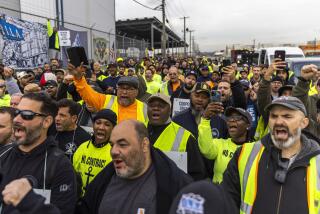1,200 Strike Nassco; Concern Expressed Over Firm’s Survival
- Share via
Union workers at the National Steel & Shipbuilding Co. went on strike Wednesday, culminating a year of fruitless negotiations and dealing another setback to the declining shipyard that once was the West Coast’s largest.
About 1,200 workers struck at noon, when hundreds of employees led by the Ironworkers Union marched out of the yard chanting slogans and waving U.S. flags. Union leaders called the strike after Nassco failed to accept their proposal for a new contract last week. No new talks are scheduled.
Six labor unions have rejected three company proposals since Sept. 30, when their contract expired, but on Tuesday night the Electricians Local 569 accepted Nassco’s latest proposal. However, the electricians have promised to honor the other unions’ picket lines.
The strike evolved from a wage dispute. Company officials, arguing that Nassco had to remain competitive with shipyard wages on the Gulf and East coasts, said workers had to accept drastic cuts.
In October, the company unilaterally imposed cuts that averaged about 17% for most management and union workers, but some unskilled workers saw their wages reduced more than 50%, from $12.05 an hour to $5.55. The average journeyman wage was trimmed to $10.80, from $12.80. Nassco has rejected a union proposal to raise journeymen to $12 an hour.
Negotiations were further strained in February, when Nassco announced that the company was giving merit increases of about 5% to some salaried employees.
At noon Wednesday, grim-faced workers began picketing immediately in front of the yard and at other entrances.
“Smiles are for party time, and who the hell is having a party?” one worker said.
“Free at last,” said a woman whose face showed the strain of almost a year of worrying about her future and that of the shipyard.
The strike, which was expected by Nassco officials, could not have come at a worse time for the company. Last month, the company reported $20 million in losses for the second quarter of 1988. Ship orders from private companies have all but disappeared, forcing Nassco to rely on dwindling contracts from the Navy, which has been awarding most contracts to shipyards on the East and Gulf coasts, where pay rates are lower.
Nassco is the only privately owned shipyard on the West Coast not in bankruptcy, but union and industry officials wonder whether it can survive.
“I am concerned about the company going under,” said Peter Zschiesche, business agent with the International Assn. of Machinists, Local 389. “I want them to be very successful. But the bottom line is what’s the price of success. It’s not $10.80 an hour for journeymen. It’s not $5.50 an hour for other workers.”
Currently, Nassco only has a $60-million contract to repair two destroyers, which are due to be delivered to the Navy by the end of the year, and a $280-million, three-year contract for the AOE, a speedy Navy combat support ship. However, Nassco spokesman Fred Hallett said work on the AOE will stop while the company finishes the repair jobs. Despite the walkout by hundreds of skilled journeymen, Hallett said, the company will meet the deadlines for the two destroyers by using salaried personnel.
However, union leaders reacted with skepticism and doubted that management workers have the skills to finish the repair jobs. Hallett acknowledged that only about 200 of the company’s 800 non-union workers “are either skilled or have the capability of doing lesser-skilled jobs required in the yard.” Zschiesche said Navy officials will not allow salaried personnel to work on the destroyers.
“I don’t have much confidence that they can do our work. . . . The Navy requires qualified people to work on their ships. . . . If I were the captain of a Navy ship and I saw these people coming into the engine room to do our work, I’d be nervous.”
Union workers said, and Hallett acknowledged, that some journeymen were used to train and certify salaried personnel to perform highly skilled jobs in the past few weeks. Hallett said this was done because “there is a requirement when you’re doing Navy work that you be certified” to do specific jobs.
Union leaders declined to say how long the strike could last.
“The stronger the strike, the shorter it will be. . . . But we’re also telling our people that it will take as long as it takes to get a better contract,” Zschiesche said.
Hallett said the company will wait about two months before deciding on its next move.
“We still have the capability of using subcontractors and hiring additional workers,” he said. “But, we will wait approximately two months before we make a decision to hire additional workers.”
More to Read
Inside the business of entertainment
The Wide Shot brings you news, analysis and insights on everything from streaming wars to production — and what it all means for the future.
You may occasionally receive promotional content from the Los Angeles Times.










